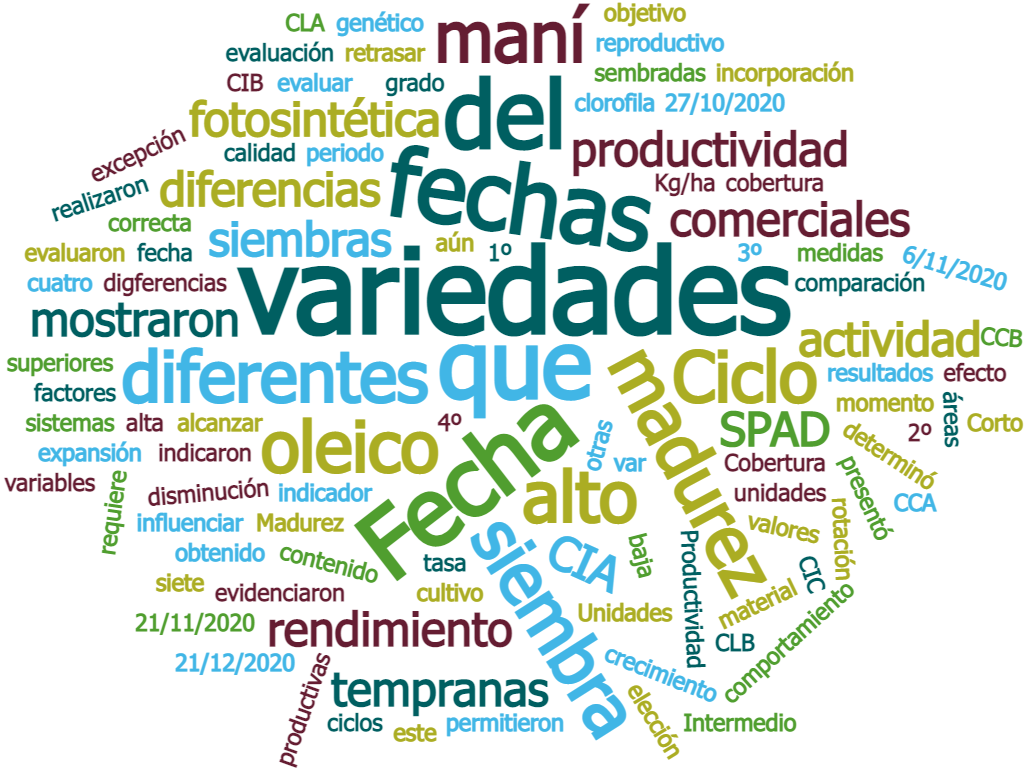Effect of sowing dates of peanuts varieties of different cycles in Córdoba Argentina
DOI:
https://doi.org/10.52755/sas.v2iedesp2.119Keywords:
Arachis hypogaea L., Cultivar, Yield , MaturityAbstract
The incorporation of peanuts in the rotation systems in new productive areas requires the evaluation of the behavior of commercial varieties for the correct choice of genetic material and the sowing date, as factors that can influence the yield and quality of the peanut obtained. The objective of this work was to evaluate the effect of the sowing dates of commercial peanut varieties of different cycles. Seven varieties were evaluated: CCA and CCB (Short Cycle and
high oleic); CIA, CIB and CIC (Intermediate Cycle, high oleic except for CIA); CLA and CLB (Long Cycle, high oleic). The sowings were carried out on four different dates: 1st Date (10/27/2020), 2nd Date (11/6/2020), 3rd Date (11/21/2020) and 4th Date (12/21/2020). The variables measured were: Coverage (%), SPAD Units as an indicator of chlorophyll content and photosynthetic activity, Maturity (%) and Productivity (Kg / ha). The results indicated that the varieties of CC in early dates allowed the crop to reach in the reproductive period, 60% coverage, values higher than 40 SPAD units, which determined high productivity and maturity. The CL varieties, although the photosynthetic activity did not show differences, the growth rate was low in relation to the other varieties, so they did not show differences in yield or maturity even in early plantings. The CL varieties did not show differences in productivity sown on different dates, but showed a decrease in the degree of maturity to delay the sowing moment.
Downloads

Downloads
Published
How to Cite
Issue
Section
License
Copyright (c) 2021 José María Gamba, Mauricio Sebastián y Pérez, Maria Perez, Cecilia Guzman, Camila Illa

This work is licensed under a Creative Commons Attribution-NonCommercial-ShareAlike 4.0 International License.
Autores concordam com os seguintes termos:
a) Os autores mantêm os direitos autorais e concedem à revista o direito de primeira publicação, com o trabalho simultaneamente licenciado sob a LicençaAttribution-NonCommercial-ShareAlike 4.0 International, que permite o compartilhamento do trabalho com reconhecimento da autoria e publicação inicial na Revista SAS. A licença permite o uso, a distribuição e a reprodução irrestrita, em qualquer meio, desde que devidamente citada a fonte. Essa licença permite também que outros remixem, adaptem e criem a partir do seu trabalho para fins não comerciais, desde que atribuam a você o devido crédito e que licenciem as novas criações sob termos idênticos.
b) Não cabe aos autores compensação financeira a qualquer título, por artigos ou resenhas publicados na South American Sciences.
c) Os conceitos expressos nos artigos publicados na South American Sciences são de inteira responsabilidade de seus autores.








